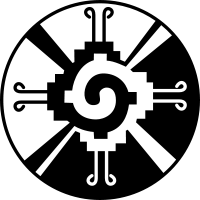 The figure on the right is a representation of the Mayan One God Hunab-Ku. According to Dr. C.J. Calleman, author of Purposeful Universe, other names given to this supreme entity of the Maya include Eight-Partition Place, the One Giver of Movement and Measure, and the One Giver of Energy and Boundary. This notion of eight partitions or octopartition would present itself again. It should be mentioned that Hunab-Ku is not regarded as an individual being, but as all BEING, the fundament of all existence.
The figure on the right is a representation of the Mayan One God Hunab-Ku. According to Dr. C.J. Calleman, author of Purposeful Universe, other names given to this supreme entity of the Maya include Eight-Partition Place, the One Giver of Movement and Measure, and the One Giver of Energy and Boundary. This notion of eight partitions or octopartition would present itself again. It should be mentioned that Hunab-Ku is not regarded as an individual being, but as all BEING, the fundament of all existence.Similarity between this hand-fashioned wireframe model at left and the 2x2x2 binary hypercube suggests itself. Likewise, there is similarity between the process of fashioning the wireframe model and Taoist cosmogony:
- Measuring, closing a strand of wire (differentiation, singularity)
- Twisting (Great Axis) a loop yields two loops (Two First Powers)
- Two loops intermingle to produce quadrants (Four Symbols)
- Twisting a orthogonal third axis results in octopartition (Eight Diagrams or Ba Gua)
 |
| Binary hypercube |
Octopartitioning is arguably special because it encompasses all spatial directions -- up, down, and all the cardinal points. If one considers the Origin (the point at the center of the cube, within is also represented.
 |
| from "Purposeful Universe" |
Thus, a galaxy, our Earth, or any physical object may be visualized or modeled by means of the octopartition. Indeed, navigation makes extensive use of this feature.
 |
| Hand-wrought copper wire |
Thus, an octopartition represents akasha, or space, but what about time? Time implies Change, else it is pointless to measure time.
 In order to represent the fourth dimension, we must account for Change, but how?
In order to represent the fourth dimension, we must account for Change, but how? The answer: repetition. That is, to arrange two similar objects to represent the first object both before and after a change as depicted in the graphic at right.
